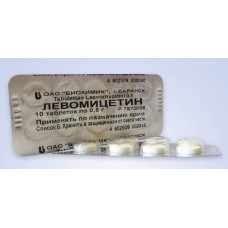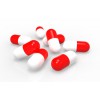Expiration date: 07/2026
Composition
1 tablet contains chloramphenicol - 500 mg
Additional ingredients: colloidal silicon dioxide (Aerosil), microcrystalline cellulose, povidone, crospovidone, calcium stearate, Opadry II (series 85) [Polyvinyl alcohol, macrogol, talc, titanium dioxide, aluminum lake based on quinoline yellow aluminum lake based on indigo] .
Packaging
20 pieces.
pharmachologic effect
Chloramphenicol - bacteriostatic antibiotic with a wide spectrum of action violates the process of protein synthesis in the microbial cell transfer step amino acid tRNA to the ribosome. It is effective against strains of bacteria that are resistant to penicillin, tetracyclines, sulfonamides. It is active against the following microorganisms: Escherichia coli, Shigella dysenteria, Shigella flexneri spp, Shigella boydiispp, Shigellasonnei, Salmonellaspp... (Including Salmonella typhi, Salmonella paratyphi), Staphylococcus spp., Streptococcus spp. (Including Streptococcus pneumoniae), Neisseria meningitidis, Neisseria gonorrhoeae, several strains of Proteus spp., Burkholderia pseudomallei, Rickettsia spp., Treponema spp., Leptospira spp., Chlamydia spp. (Including Chlamydia trachomatis), Coxiella burnetii, Ehrlichia canis, Bacteroides fragilis, Klebsiella pneumoniae, Haemophilus influenzae. Not valid for acid bacteria (including Mycobacteriumtuberculosis), anaerobes, methicillin-resistant strains of staphylococci, Acinetobacterspp., Enterobacterspp., Serratiamarcescens, indolpolozhitelnye strains Proteusspp., Pseudomonasaeruginosaspp., Protozoa and fungi. Resistant microorganisms developed slowly.
testimony
Infections of the urinary and biliary tract, caused by susceptible microorganisms.
Contraindications
Hypersensitivity, inhibition of bone marrow hematopoiesis, acute intermittent porphyria, lack of glucose-6-phosphate dehydrogenase, liver and / or kidney failure, skin diseases (psoriasis, eczema, fungal), pregnancy, lactation, children under 3 years of age and / or body weight less than 20 kg.
Dosing and Administration
Chloramphenicol taken orally (for 30 minutes before a meal, while the development of nausea and vomiting - 1 hour after a meal), 3-4 times a day. The single dose for adults - 0.25-0.5 grams daily - 2 Years In severe infections (hospital) may increase the dose to 3-4 g / day (under the control of the blood condition, kidney and liver). Children older than 3 years old and / or weighing more than 20 kg administered 12.5 mg / kg every 6 hours or 25 mg every 12 hours, in severe infections - up to 75-100 mg / kg / day (under the control of serum concentrations of the drug). The average duration of treatment - 8-10 days.
Side effects
From the digestive system: dyspepsia, nausea, vomiting (likely to develop reduced when taking 1 hour after eating), diarrhea, irritation of the oral mucosa and pharynx, dermatitis, goiter (suppressing the normal microflora).
From the side of hematopoiesis: reticulocytopenia, leukopenia, granulocytopenia, thrombocytopenia, erythropenia rarely - aplastic anemia, agranulocytosis.
From the nervous system: psychomotor disorders, depression, confusion, peripheral neuritis, optic neuritis, visual and auditory hallucinations, decreased visual acuity and hearing, headache.
Allergic reactions: skin rash, angioedema.
Other: a secondary fungal infection.
special instructions
Severe complications of the haematopoietic system, usually associated with high doses for a long time. At simultaneous reception of ethanol development disulfiramopodobnyh reaction (facial flushing, abdominal cramps and in the stomach, nausea, vomiting, headache, decreased blood pressure, tachycardia, shortness of breath).
Drug interactions
Chloramphenicol inhibits the enzyme system cytochrome the P450, so while the use of phenobarbital, phenytoin, indirect anticoagulants marked weakening of the metabolism of these drugs, slow excretion and increasing their plasma concentrations. It reduces the antibacterial effect of penicillins and cephalosporins. In an application with erythromycin, clindamycin, lincomycin noted the mutual weakening of the action due to the fact that chloramphenicol can displace these medicines from the bound state, or prevent them from binding to 50S subunit of the bacterial ribosome. Co-administration with drugs, oppressive blood (sulfonamides, cytostatics), affecting the metabolism of the liver, with radiation therapy increases the risk of side effects. In the appointment of oral hypoglycemic drugs has increased, their actions (by suppressing the metabolism in the liver and increase their concentration in plasma). Myelotoxic drugs increase the expression gematotoksichnosti drug.
Overdose
Symptoms: nausea, vomiting.
Treatment: gastric lavage, symptomatic therapy, hemosorbtion.
Storage conditions
Store in a dry, dark place at a temperature no higher than 25 ° C.
Shelf life: 2 years.
* The appearance of the packaging may vary from photo


